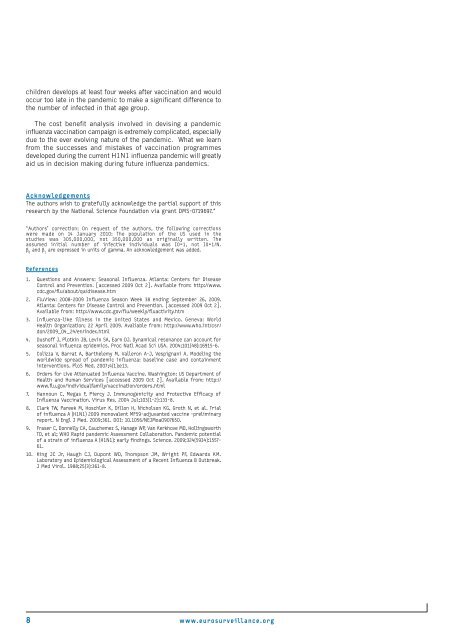Volume 14, Issue 41 - 15 October 2009 - Eurosurveillance
Volume 14, Issue 41 - 15 October 2009 - Eurosurveillance
Volume 14, Issue 41 - 15 October 2009 - Eurosurveillance
You also want an ePaper? Increase the reach of your titles
YUMPU automatically turns print PDFs into web optimized ePapers that Google loves.
children develops at least four weeks after vaccination and would<br />
occur too late in the pandemic to make a significant difference to<br />
the number of infected in that age group.<br />
The cost benefit analysis involved in devising a pandemic<br />
influenza vaccination campaign is extremely complicated, especially<br />
due to the ever evolving nature of the pandemic. What we learn<br />
from the successes and mistakes of vaccination programmes<br />
developed during the current H1N1 influenza pandemic will greatly<br />
aid us in decision making during future influenza pandemics.<br />
Acknowledgements<br />
The authors wish to gratefully acknowledge the partial support of this<br />
research by the National Science Foundation via grant DMS-0719697.*<br />
*Authors’ correction: On request of the authors, the following corrections<br />
were made on <strong>14</strong> January 2010: The population of the US used in the<br />
studies was 305,000,000, not 350,000,000 as originally written. The<br />
assumed initial number of infective individuals was I0=1, not I0=1/N.<br />
β 0 and β 1 are expressed in units of gamma. An acknowledgement was added.<br />
References<br />
1. Questions and Answers: Seasonal Influenza. Atlanta: Centers for Disease<br />
Control and Prevention. [accessed <strong>2009</strong> Oct 2]. Available from: http://www.<br />
cdc.gov/flu/about/qa/disease.htm<br />
2. FluView: 2008-<strong>2009</strong> Influenza Season Week 38 ending September 26, <strong>2009</strong>.<br />
Atlanta: Centers for Disease Control and Prevention. [accessed <strong>2009</strong> Oct 2].<br />
Available from: http://www.cdc.gov/flu/weekly/fluactivity.htm<br />
3. Influenza-like illness in the United States and Mexico. Geneva: World<br />
Health Organization; 22 April <strong>2009</strong>. Avaliable from: http://www.who.int/csr/<br />
don/<strong>2009</strong>_04_24/en/index.html<br />
4. Dushoff J, Plotkin JB, Levin SA, Earn DJ. Dynamical resonance can account for<br />
seasonal influenza epidemics. Proc Natl Acad Sci USA. 2004;101(48):169<strong>15</strong>-6.<br />
5. Colizza V, Barrat A, Barthelemy M, Valleron A-J, Vespignani A. Modeling the<br />
worldwide spread of pandemic influenza: baseline case and containment<br />
interventions. PloS Med. 2007;4(1):e13.<br />
6. Orders for Live Attenuated Influenza Vaccine. Washington: US Department of<br />
Health and Human Services [accessed <strong>2009</strong> Oct 2]. Available from: http://<br />
www.flu.gov/individualfamily/vaccination/orders.html<br />
7. Hannoun C, Megas F, Piercy J. Immunogenicity and Protective Efficacy of<br />
Influenza Vaccination. Virus Res. 2004 Jul;103(1-2):133-8.<br />
8. Clark TW, Pareek M, Hoschler K, Dillon H, Nicholson KG, Groth N, et al. Trial<br />
of influenza A (H1N1) <strong>2009</strong> monovalent MF59-adjuvanted vaccine -preliminary<br />
report. N Engl J Med. <strong>2009</strong>;361. DOI: 10.1056/NEJMoa0907650.<br />
9. Fraser C, Donnelly CA, Cauchemez S, Hanage WP, Van Kerkhove MD, Hollingsworth<br />
TD, et al; WHO Rapid pandemic Assessment Collaboration. Pandemic potential<br />
of a strain of influenza A (H1N1): early findings. Science. <strong>2009</strong>;324(5934):<strong>15</strong>57-<br />
61.<br />
10. King JC Jr, Haugh CJ, Dupont WD, Thompson JM, Wright PF, Edwards KM.<br />
Laboratory and Epidemiological Assessment of a Recent Influenza B Outbreak.<br />
J Med Virol. 1988;25(3):361-8.<br />
8 www.eurosurveillance.org

















